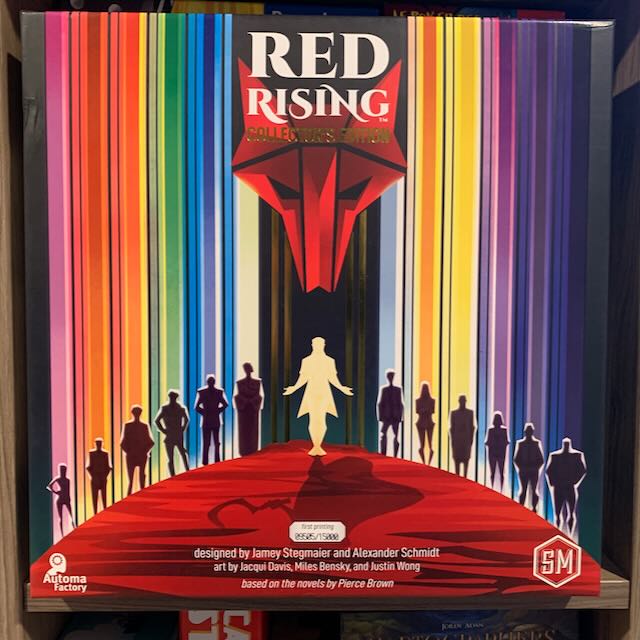
As our kids get older and our lives become busier, I value games that have good puzzles with shorter playtimes that are accessible to a wide range of people. Red Rising first caught my attention for being a Stonemaier game having a playtime of about an hour. Researching more on the game sparked my interest further.
Hand management? Cool, I really don’t have a pure hand management game yet. Light to medium complexity? Nice, I may be able to get this to the table with my casual gamer friends and family. Up to 6 players? Sweet, no one will be sitting on the sidelines. It appears to have all the makings of a game that would sit in my wheelhouse. I will admit I do not know much about the books that the game is based on, but I am hoping my lack of knowledge on the Red Rising universe does not detract from my experience playing the game.
Red Rising Overview
Red Rising, designed by Jamey Stegmaier and Alexander Schmidt and published by Stonemaier Games, is a card game for 1-6 players set in the dystopian Red Rising universe of books by Pierce Brown. The term card game is used a bit loosely here. Unpacking the collector’s edition had a lot more than just cards. The components I was parsing through were certainly top notch. Metal cubes and tokens, plastic jewels (helium), a nice oversized custom die, quality card stock and a nice insert to keep everything in place. Stonemaier Games is a publisher known for quality components and the collector’s edition of Red Rising is no exception.
Set Up
Set up of the game is simple. Layout the board and place 2 character cards in each location. There are 4 locations on the board each representing an area you can place and draw cards from or rewards that you can receive. When placing cards during setup and throughout the game, you will overlap them vertically so just the name and color of the previous card is showing. The remaining character cards are set face down in a stack in the middle of the board. The container of helium jewels and sovereign token are set on the board just below the character cards.
Next, players take a house tile at random. These tiles have unique abilities that can be triggered when the sovereign token is acquired by the player. Players will then take the matching color set of fleet tokens and cubes (influence tokens). The fleet token is set at the zero space on the fleet track and influence tokens are placed in front of the player as a personal supply. Finally, each player is dealt 5 character cards from the center deck to form their starting hand. In practice, this is a set up time that is below a minute.
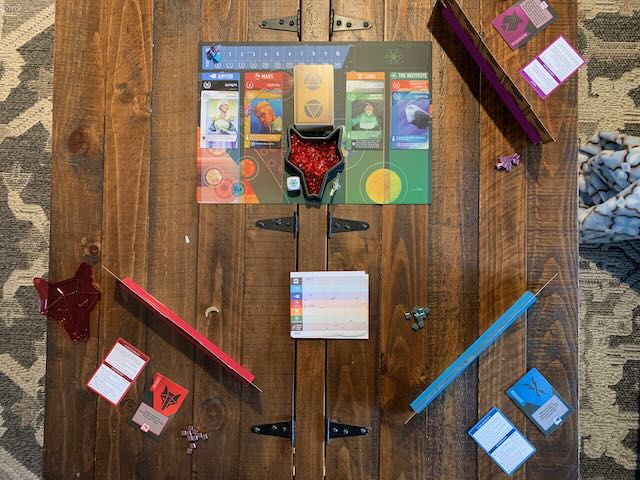
Lucky Number 7
The goal of Red Rising is to be the player with the most accumulated points by the time end game conditions are met. End game conditions trigger based on players having accumulated 7 in each helium, influence, and progression on the fleet track. It is not enough for just one of these conditions to trigger end game however. Either all 3 conditions must be met by any combination of players around the table or a single player must satisfy 2 of the 3 conditions to trigger the end of the game. Once end of game is triggered, players finish out the round so that all players have had an equal amount of turns playing cards. Points are then tallied and a winner is declared.
Red Rising Gameplay
Leave a Card, Take a Card
The core gameplay in Red Rising revolves around hand management. Players will be playing and collecting cards to better the hand of cards that they are holding for the end game. The actions that a player can take on their turn are also fairly straight forward. On their turn, a player has a choice of:
- Leading – Players play a card in their hand onto the board at one of the 4 locations. Then either take the top card from the remaining 3 locations or draw a random card from the top of the character deck to place in their hand. If you choose the latter, you get to roll the die and collect a random reward.
- Scout – Players draw a random card from the top of the deck and place it at a location. You then collect the reward for that location.
These 2 actions will have you swapping cards in your hand has you hunt for cards that will better your end game score.
Holding All the Cards
Seems pretty simple right? I though so too during my research but there is a lot going on during that card play. There is a lot of information on the cards that determine scores and what cards you may be hunting for as your play. When you play a card at a location, there are effects on the card that are triggered. These range from being able to pull cards from under the top card at a location, to “banishing” cards, to receiving bonuses if you have more helium or influence than the player next to you. Playing some of these cards will also allow you to collect the sovereign token that triggers your special ability.
In addition to paying attention to the actions that these cards produce you are also paying attention to the points the cards yield. Cards typically generate points in 2 ways. There is a static point value at the top of the card that you receive for having the card in your hand. Then there are end game point values at the bottom of the card. These are often triggered off of other cards you have in your hand. It is this information that will have you combing through the deck to better your position.
Combos, Combos, Everywhere
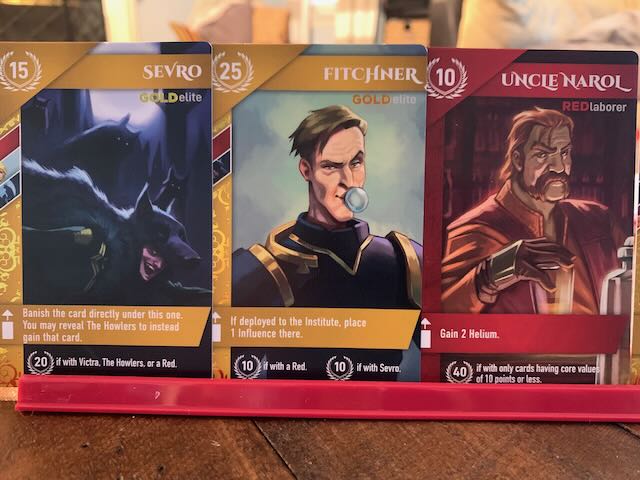
Trying to complete these end game point scenarios will often have you picking up other cards to satisfy a requirement. Some require to be paired with other character or color cards to score. Others will cause you to lose points if there is a certain type of card in your hand at the end of the game. Still others serve as wild cards that let you change the card to meet goals of other cards you have. With over 100 cards in the deck there are tons of combos to hunt for the best possible hand.
We Are in the End Game Now
Card play in Red Rising is the star. But you also need to pay attention to getting to that end game that I mentioned before. No only will collecting helium, raising influence, or moving up the fleet track trigger end game but you receive points. Each one is calculated differently, and may be the difference between victory and defeat. If there are no cards on the board that you feel can improve your hand, take that scout action and start moving up in those end game conditions! By placing those cards at the different locations during scouting you can take the unique reward each location. You will be raising your fleet, helium, and influence by scouting.
Red Rising Impressions
Components
There is no doubt the components in the collector’s edition are top notch. Card art was really well done. It is a nice touch that not only do they have colors but also the names of the colors on the cards. During my play through with my gaming group there was more than one time the name of the color on the card helped with pairing a combo. There are many different colors in the game. Some are tough to distinguish between each other and this helped out. The art on the cards was wasted on me, however. Partially because I was paying so much attention to all the other information the cards contained and my lack of knowledge of the Red Rising universe.
Playtime
The game does play in a reasonable time. Even with my group going in cold, we finished our first play through in about an hour. Subsequent plays with my wife clocked in at about 30-45 minutes. This is a good length for a game of this type but for some reason feels like it is longer than that. This is a good thing as I was laser focused on cards being played and everything else going on that I lost track of time.
Accessibility
Like I mentioned before, there is quite a bit going on during the game. It is nice that there are many paths to victory. I think new or casual players may have a hard time tracking everything between the card anatomy, combos, and endgame conditions. Not sure this would be a game that I would break out to friends who are not really gamers for a first time play. I think that if you have a mix of folks that have played before and new players it will hit better. Subsequent plays got smoother and faster each time.
Game Play
My first play with my gaming group was interesting. When we began, it felt kind of overwhelming with all the choices of cards and directions you could take. As cards were played, strategies began to crystalize and your hand of cards starts to take shape. In the beginning these decisions are really crunchy and mathy. Do I drop this card that is worth 20 points and grab a card that is only worth 9 but gives me an end game bonus of 26 (if I can meet it)? Oh, but it also combos with another card in my hand to trigger that bonus too! No brainer. After several rounds I had a hand that I felt good about and my decisions almost became binary, but still mathy. Is there a card out there for me or not?
This was when my focus started to turn to scouting. Over several rounds, I found my self scouting to build my influence and fleet status to trigger the end game. This provides a nice dynamic of game pace and using that to your advantage if you have a good hand. There is a good balancing act here between hand management and building to the end game for your final score.
It is also kind of difficult to get an idea of who is leading during the course of the game. In one game, I though a player was running away with victory based on the amount of cards he collected. Once scores were tallied however, another player was revealed as the winner. The game does have a bit of a solitaire feel in that respect. The emphasis on keeping tabs on what other cards players were collecting and playing did not seem as important as tracking the end game conditions amongst the players.
End Scoring, Lots of Points
Lots of points are to be had in Red Rising. For end game scoring, we were breaking out our phones to do the math. It is not complicated once you get the hang of it, there is just a lot of it. On your scoring sheet there are 7 categories you are calculating to find your end game score. Between points and combos on cards, fleet score, helium, influence and number of cards in your hand, it is not uncommon to have scores in the 250 plus range after completing a game. Again, this is certainly an aspect that benefits from multiple plays and becomes more intuitive.
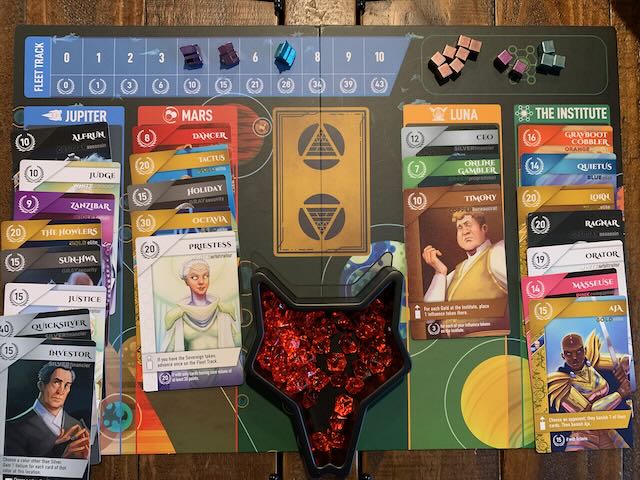
Red Rising Final Thoughts
Overall I enjoyed playing Red Rising. My first play was a bit awkward but the game got significantly smoother after more plays were under my belt. I did enjoy the combos that you could pull off. The balancing act of managing your hand while driving towards the end game always resulted in choices that were meaningful. While not as accessible as I initially thought it would be, it’s a game that I can get to the table with a decent range of people. Playtime is brisk and the game does not overstay its welcome. Having control of when the game ends ensures this. As far as having prior experience with the Red Rising? Not needed. In fact, I am kind of inclined to check out the books after playing to flesh out the relationships with the characters in the game.
Final Verdict on Red Rising

This initially started out as a middle of the road game for me. But the more I played the more it grew on me. Due to the sheer volume of cards, no two games will play out the same. The variety is through the roof! If you want a game that plays quick with good choices and lots of scoring opportunities this may be a great game for you. Once you get the hang of it.





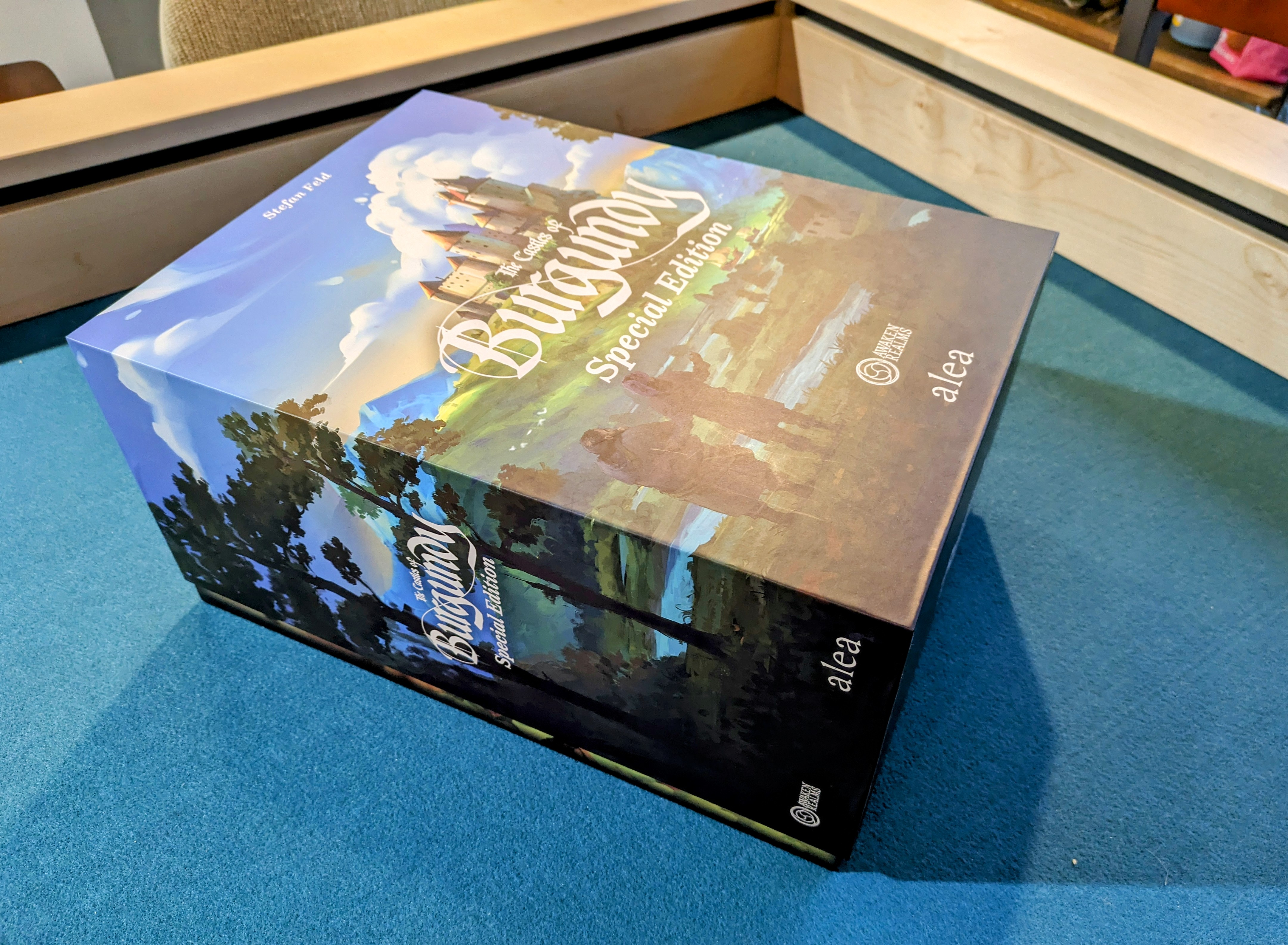
Brad H
March 31, 2022 12:46 pmPerfect summation. Would definitely play again.